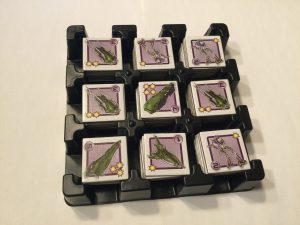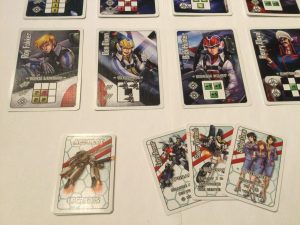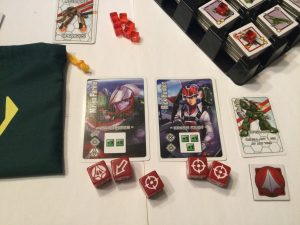| Publisher | Japanime Games |
| Design Credits | Jeff Mechlinski |
| Art Credits | Francisco Etchart, Jeff Mechlinski |
| Game Contents | Token Tray, 100 Tokens (one First Player Token, eight Upgrade Tokens, 91 Zentraedi Ship Tokens), Cloth Bag, 10 plastic Damage Markers, eight Hero Cards, eight Upgrade Cards, five Robotech Action Dice, rules |
| Guidelines | Giant Robot Trophy-Taking Game |
| MSRP | $24.95 |
| Reviewer | Andy Vetromile |
If you thought the animated Robotech franchise was going to slow down, Japanime Games is here to show you otherwise. They’ve produced a few products for the line including a ship-defense board game and some neat fan accessories, and here now is Robotech: Ace Pilot, their dice-roller, pitting everyone against alien Zentraedi ships in a bid to be the hero of the hour.
The object is to score the most points.
Two to four gung-ho guys and gals hop into the pilot’s seat to take the fight to the Zentraedi, an invading force that seeks to overrun Earth. Your targets are stacks of Tokens (yes, this is one of those games where everything is capitalized) placed in a handy Tray in a 3 × 3 formation but you’re going to need teammates, so you take turns rolling the five Action Dice to recruit assistance. You can roll three times, keeping and discarding results as you go, or stand pat whenever you like. The six-siders show special symbols that also appear on Hero Cards, various personae from the anime series; match the dice to the card and you control the character for the round. Each has a power or advantage to apply against enemies in the display . . . for example, pilot Roy Fokker does two points of damage to everything in one quadrant of the tray while communications specialist Claudia Grant does one point to all in one row or column.
If an enemy isn’t killed outright, plastic cubes track his damage from turn to turn; otherwise destroyed Tokens are collected as trophies for their printed point value. There are also Upgrade Tokens to earn cards with abilities one may employ when the time is right. At the end of one’s turn any defeated pieces give way to the next Token in the stack for the new player. Everyone takes turns rolling, choosing, attacking, and removing, though as Heroes are collected from the pool there are fewer options for the next person. Each player gets a chance to take the fight to the enemy before the round ends; the Heroes then return to the center to be “bought” anew; and the first player position rotates. This continues until two of the Tray’s cells are empty of little bad guy chits, signaling the end of the war (and the game). The pilot with the highest score is humanity’s favorite.
The plastic Tray is key to the success or failure of the game, and it acquits itself okay. It sits in the box like an insert but it removes effortlessly. It’s a bit too easy for the tokens sitting in it to shift so they’re oriented like diamonds instead of squares (or to flip over or slide out and around entirely), but this is more a transport issue; it does keep them in their separate positions during play. It doesn’t make it any less unwieldy to dig the Tokens out – finger space is at a premium – and loading and unloading it is the most time-consuming element of the game. One need not worry someone memorized everything in a single cell of the Tray so storing the Tokens without regard to their faceup or face-down status is no biggie; as long as each cell has the right number of chits, purists in the group should have no complaints.
It seems odd the symbols on the Hero Cards couldn’t be made to stand out more, but the whitish hue on some is eaten up by the background. There’s a dandy but ultimately superfluous Cloth Bag with the Zentraedi symbol on it that can carry the Damage Markers, dice, and maybe the cards. It’s supposed to be used for mixing the Tokens but it barely contains all of them; forget jumbling them up. The artwork is marvelous (they do have 30+ years of material from which to draw inspiration, after all). The dice are pretty, though they don’t seem to roll Spacys often – are they badly made or is it simply the result of a limited data set? The rules leave few questions unanswered (though surely there must have been a more elegant way to describe Captain Gloval’s ability to commandeer the First Player Token).
Fans of the franchise will appreciate the attention to their jam, and thematically Robotech: Ace Pilot tries to cater to the story – Rick Hunter is the only one who can eliminate Khyron’s chit when it appears, for example. Then again, Lynn Minmei is relegated to being an unnamed Pop Star worth VPs at game’s end.
The game plays quickly – too quickly, really, though it’s easy to extend it by agreeing to empty more cells in the Token Tray before initiating the finale – so it can start or end an evening or serve as a palate cleanser between bigger efforts. The strategy isn’t deep but it’s a bit more than a simple dice-roller. Trying to decide which cards to buy, which ones allow you to destroy big-ticket items without leaving damaged units for your opponents to bat clean-up on, occupies you. Having to leave units with damage markers would work well as a catch-up mechanism but it seems to come up only rarely. Only if you’re good at “counting cards” (or in this case tokens, so you know who has how many points) is there much decision-making regarding whether to activate endgame conditions on your turn, and interfering with another player’s strategy doesn’t factor in.
Robotech: Ace Pilot is a fast game, maybe half an hour including rules explanation, with an entertaining theme and enough chewiness to offer occasional replay value. It probably won’t be a mainstay for any but the diehard anime fans but it’s a great warmup exercise for fast fun.



